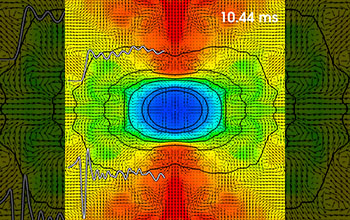Multimedia Gallery
Simulation shows how to detect rapidly spinning stellar core
The inner regions of a collapsing, rapidly spinning massive star. The colors indicate entropy, which roughly corresponds to heat: red regions are very hot, while blue regions are cold. The black arrows indicate the direction of the flow of stellar material. The two white curves with black outlines indicate the neutrino (top) and gravitational-wave (bottom) signals. This frame shows a simulation about 10.5 milliseconds after the stellar core has become a dense proto-neutron star.
More about this image
Each century, about two massive stars in our own galaxy explode, producing magnificent supernovae that send fundamental, uncharged particles, called neutrinos, streaming our way and generating ripples, called gravitational waves, in the fabric of space-time.
Scientists are waiting for the neutrinos and gravitational waves from about 1,000 supernovae that have already exploded at distant locations in the Milky Way to reach us. Here on Earth, large, sensitive neutrino and gravitational-wave detectors have the ability to detect these respective signals, which will provide information about what happens in the core of collapsing massive stars just before they explode. But if researchers are to understand that data, however, they will need to know in advance how to interpret the information the detectors collect.
In 2012, researchers at the California Institute of Technology (Caltech) found via computer simulation what they believe is an unmistakable signature of a feature of such an event: if the interior of a dying star is spinning rapidly just before it explodes, the emitted neutrino and gravitational-wave signals will oscillate together at the same frequency.
"We saw this correlation in the results from our simulations and were completely surprised," said Christian Ott, an assistant professor of theoretical astrophysics at Caltech and the lead author of a paper published about the research. "In the gravitational-wave signal alone, you get this oscillation even at slow rotation. But if the star is very rapidly spinning, you see the oscillation in the neutrinos and in the gravitational waves, which very clearly proves that the star was spinning quickly -- that's your smoking-gun evidence."
This research was supported by the National Science Foundation (grants AST 08-55535, OCI 0905046 and PHY 0960291).
To learn more about this research, see the CalTech news story Peering Into the Heart of a Supernova. (Date image taken: July 2012; date originally posted to NSF Multimedia Gallery: Dec. 26, 2017)
Credit: Simulation by Christian D. au (Caltech); visualization by Steve Drasco (Grinnel College and Caltech)
Images and other media in the National Science Foundation Multimedia Gallery are available for use in print and electronic material by NSF employees, members of the media, university staff, teachers and the general public. All media in the gallery are intended for personal, educational and nonprofit/non-commercial use only.
Images credited to the National Science Foundation, a federal agency, are in the public domain. The images were created by employees of the United States Government as part of their official duties or prepared by contractors as "works for hire" for NSF. You may freely use NSF-credited images and, at your discretion, credit NSF with a "Courtesy: National Science Foundation" notation.
Additional information about general usage can be found in Conditions.
Also Available:
Download the high-resolution JPG version of the image. (16.2 MB)
Use your mouse to right-click (Mac users may need to Ctrl-click) the link above and choose the option that will save the file or target to your computer.



